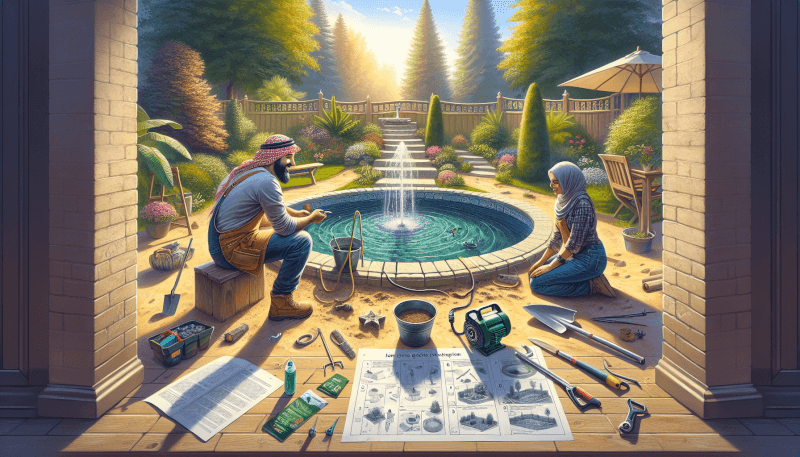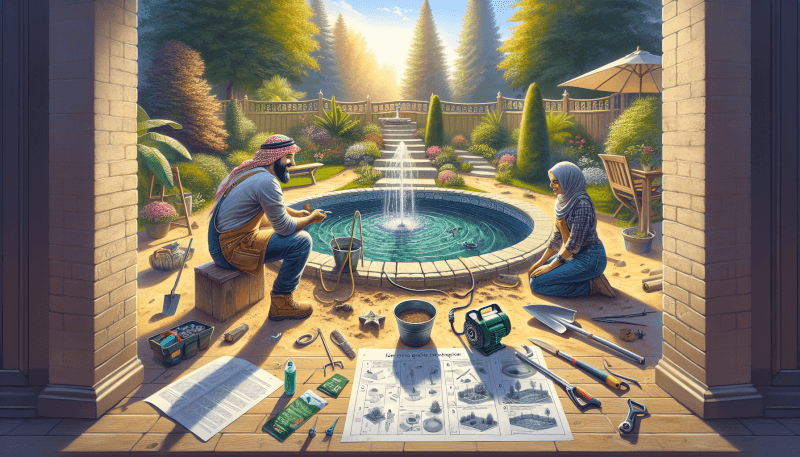If you’ve always dreamt of having a serene and captivating water feature in your garden, then building your own DIY garden pond fountain might be just the perfect project for you! Not only will it add a touch of tranquility to your outdoor space, but it will also provide a soothing sound of flowing water. In this article, you will discover an easy step-by-step guide on how to create your very own garden pond fountain, allowing you to bring the beauty of nature right to your backyard. So grab your tools and get ready to embark on an exciting journey of creating a stunning oasis that will surely impress your friends and family.

Materials and Tools
To build your own DIY garden pond fountain, you will need several materials and tools to ensure success. Here are some essential items you will require:
Selecting the Right Pond Liner
First and foremost, you need to select the right pond liner for your fountain. Pond liners are available in various materials such as rubber, PVC, or EPDM. Consider the size and depth of your pond when selecting the liner to ensure it can withstand the water volume and won’t leak.
Choosing the Fountain Pump
A fountain pump is crucial for creating the beautiful cascading water feature in your pond. Select a pump that suits the size of your pond and the desired flow rate. Additionally, ensure the pump is designed for outdoor use to withstand the elements.
Garden Hose
Having a garden hose nearby will make filling and maintaining your pond fountain much easier. Opt for a hose that is long enough to reach your pond comfortably. Ensure it has a twist-free design and a durable construction.
Landscape Rocks and Gravel
Landscape rocks and gravel add aesthetic appeal to your garden pond fountain. Select rocks and gravel of various sizes and colors to create a natural and visually appealing environment. Make sure they are non-toxic and safe for use in water.
Water Plants and Fish
Introducing water plants and fish to your pond fountain will enhance its ecosystem and create a vibrant and lively atmosphere. Consider the types of plants and fish that will thrive in your climate and pond size. Consult your local garden center for expert advice.
Basic Tools
Lastly, gather some basic tools before starting your DIY project. You may need a measuring tape, utility knife, shovel, level, and wrenches for assembly and installation. These tools will help ensure a smooth and efficient construction process.
Designing Your Pond Fountain
Before you dive into building your DIY garden pond fountain, it’s important to plan and design it carefully. Consider the following factors to create a stunning water feature in your garden:
Determining the Location
Selecting the right location for your pond fountain is crucial. Find an area in your garden that receives a good balance of sunlight and shade. Additionally, consider the visibility of the fountain from different angles and choose a spot that provides a pleasant view from multiple vantage points.
Considering the Size and Shape
The size and shape of your pond fountain will largely depend on the available space in your garden. A larger garden can accommodate a sizable pond, while a smaller garden may require a more compact design. Measure the available space and visualize different pond layouts to decide on the dimensions that best suit your garden.
Deciding on the Style and Theme
Your DIY garden pond fountain can reflect your personal style and enhance the overall theme of your garden. Consider the existing elements and aesthetics in your outdoor space and choose a style that complements them. Whether you prefer a modern, natural, or whimsical look, let your creativity flow when designing the style and theme of your pond fountain.

Preparing the Site
Now that you have a plan in place, it’s time to prepare the site for your pond fountain construction. Follow these steps to ensure a smooth setup:
Marking the Pond Area
Using spray paint or wooden stakes and string, mark the perimeter of your pond area. This will give you a clear visual of the pond’s boundaries and help guide the excavation process.
Clearing the Area
Remove any vegetation, rocks, and debris from the marked pond area. Clearing the site will create a clean canvas for the construction process and prevent any obstructions or damage to the liner.
Leveling the Ground
Leveling the ground is essential to ensure the stability and balance of your pond fountain. Use a shovel or a garden rake to level the soil and remove any bumps or unevenness. Take your time to achieve a smooth surface for the next steps of the installation process.
Installing the Pond Liner
Now that your site is prepared, it’s time to install the pond liner. Follow these steps for a proper installation:
Measuring and Cutting the Liner
Carefully measure the dimensions of your pond area, adding an extra foot on all sides to allow for proper fitting. Using these measurements, cut the pond liner to the appropriate size. A utility knife or sharp scissors can be used for this task.
Preparing the Liner for Installation
Before placing the liner in the pond area, unfold it and allow it to relax in the sun for a few hours. This will help eliminate any folds or creases and make the liner more pliable during installation. Ensure the liner is clean and free from any dirt or debris before proceeding.
Laying down the Liner
Gently place the pond liner in the marked area, ensuring it covers the entire surface uniformly. Make sure to eliminate any wrinkles or air pockets by carefully smoothing out the liner with your hands. Pay special attention to the corners and edges to ensure a secure fit.

Setting up the Fountain Pump
The fountain pump is the heart of your pond fountain, creating the delightful water display. Follow these steps to set up the fountain pump efficiently:
Choosing the Right Size Pump
Select a fountain pump that suits the dimensions and design of your pond fountain. Consider the desired flow rate, head height (the vertical distance from the pump to the top of the fountain), and any additional features such as adjustable flow or multiple fountain heads. Consult the pump manufacturer’s guidelines or a professional for assistance if needed.
Installing the Pump
Carefully position the pump in the deepest part of your pond, ensuring the electrical cord is accessible but hidden from view. If your pump includes an intake strainer or sponge filter, attach it securely to the pump to prevent debris from clogging the pump mechanism.
Connecting the Pump to the Fountain
Attach the appropriate tubing or hoses to the pump’s outlet, following the manufacturer’s instructions. If your pond fountain features multiple tiers or fountain heads, attach the corresponding tubing or attachments to create the desired water display. Ensure all connections are tight and secure to prevent water leakage.
Creating the Water Circulation System
To maintain a healthy and balanced environment for your pond fountain, it’s essential to create a proper water circulation system. Follow these steps for optimal water circulation:
Adding a Water Filter
Installing a water filter is crucial for removing debris, algae, and other impurities from the water. Depending on the size of your pond, choose either a mechanical or biological filter. Follow the manufacturer’s instructions to install the filter appropriately and ensure proper functionality.
Installing a Water Return
To maintain water circulation, it’s essential to install a water return feature. This feature helps return filtered water back into the pond, keeping the water oxygenated and promoting a healthy environment for plants and fish. Position the water return outlet, such as a spray bar or waterfall, in a way that promotes water movement throughout the entire pond.
Positioning the Fountain Nozzles
If your pond fountain includes various fountain heads or nozzles, experiment with different positions to create the desired water spray patterns. Pay attention to the wind direction and adjust the nozzle positions accordingly to prevent unnecessary water loss or splash.

Adding Natural Elements
To create a visually appealing and natural-looking pond fountain, incorporate natural elements that blend harmoniously with the surroundings. Follow these steps to enhance your water feature:
Arranging Landscape Rocks
Carefully arrange landscape rocks around the edges and base of your pond fountain. Use rocks of different sizes and shapes to create a natural and organic appearance. Ensure the rocks are secure and stable to prevent them from shifting or falling into the pond.
Placing Gravel and Sand
Spread a thin layer of gravel or sand on the bottom of your pond fountain. This not only enhances the aesthetics but also provides a natural habitat for beneficial bacteria and aquatic plants. Rinse the gravel or sand before use to remove any debris or dirt.
Adding Water Plants and Fish
Introduce water plants and fish to your pond fountain to create a vibrant and lively ecosystem. Choose aquatic plants such as water lilies, lotus, or floating plants that can thrive in your climate and pond size. When adding fish, ensure they are compatible with the plants and other inhabitants of the pond.
Adding the Finishing Touches
To make your DIY garden pond fountain truly stand out, consider adding some finishing touches. Follow these steps to enhance the overall ambiance of your water feature:
Placing Decorative Elements
Add decorative elements such as sculptures, statues, or natural objects like driftwood or shells to enhance the visual appeal of your pond fountain. Ensure these elements are weather-resistant and won’t pose a risk to the pond environment or its inhabitants.
Adding Lighting
Install underwater or landscape lighting to illuminate your pond fountain during the evening hours. This will create a mesmerizing visual effect and allow you to enjoy your garden oasis even after sunset. Use low-voltage LED lights for energy efficiency and safety.
Adding a Bench or Sitting Area
Consider incorporating a bench or sitting area near your pond fountain to create a cozy and tranquil space for relaxation and contemplation. This will allow you and your guests to fully enjoy the beauty and serenity of your water feature.

Maintaining Your Pond Fountain
To keep your DIY garden pond fountain in top condition, regular maintenance is crucial. Follow these steps to ensure the longevity and health of your water feature:
Regular Cleaning and Maintenance
Regularly remove debris such as leaves, twigs, or algae from the water surface. Check and clean the water filter regularly to prevent clogging. Trim and remove any overgrown plants to maintain a balanced ecosystem. Keep an eye on the water level to ensure it doesn’t decrease significantly.
Monitoring Water Quality
Regularly test the water quality using a water testing kit. This will help you maintain appropriate pH levels, monitor ammonia and nitrate levels, and ensure the overall health of your pond ecosystem. Take necessary corrective measures if any levels are out of balance.
Winterizing the Pond Fountain
Before winter arrives, be sure to winterize your pond fountain to protect it from freezing temperatures. Remove and store any delicate water plants and relocate fish to a suitable indoor tank if necessary. Install a pond heater or aerator to prevent the water from freezing completely.
Troubleshooting and Common Issues
Even with proper maintenance, occasional issues may arise with your pond fountain. Here are some common problems and possible solutions:
Low Water Flow
If you notice a decrease in water flow, check for blockages or clogging in the pump intake or tubing. Clean or replace the filter if necessary. Ensure the pump is adequately sized for your pond and that it’s functioning properly. If the issue persists, consult a professional for further assistance.
Algae Growth
Algae growth in your pond can be controlled by maintaining appropriate water chemistry and reducing excessive sunlight exposure. Introduce algae-eating fish or use algaecides as a last resort. Regularly clean and remove any excess algae to prevent it from overtaking the pond.
Pump Malfunction
If your pump stops working or experiences a decrease in performance, first check that it’s plugged in correctly and that there are no tripped circuit breakers. Inspect the impeller for any blockages or damage, and clean or replace as necessary. If the issue persists, contact the pump manufacturer for further guidance.
By following these comprehensive steps, you’ll be well on your way to building your own DIY garden pond fountain. Enjoy the soothing sounds of cascading water and the beauty of a vibrant aquatic ecosystem right in your backyard!


